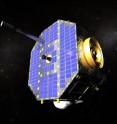IBEX finds surprising changes at solar boundary
When NASA launched the Interstellar Boundary Explorer (IBEX) on October 19, 2008, space physicists held their collective breath for never-before-seen views of a collision zone far beyond the planets, roughly 10 billion miles away. That's where the solar wind, an outward rush of charged particles and magnetic fields continuously spewed by the Sun, runs into the flow of particles and fields that permeates interstellar space in our neighborhood of the Milky Way galaxy. No spacecraft had ever imaged the collision zone, which occurs in a region known as the heliosheath, because it emits no light. But the two detectors on IBEX are designed to "see" what the human eye cannot. The interaction of the solar wind and interstellar medium creates energetic neutral atoms of hydrogen, called ENAs, that zip away from the heliosheath in all directions. Some of these atoms pass near Earth, where IBEX records their arrival direction and energy. As the spacecraft slowly spins, the detectors gradually build up pictures of the ENAs as they arrive from all over the sky.
Mission scientists got their first surprise six months after launch, once the spacecraft had scanned enough overlapping strips of sky to create a complete 360° map. Instead of recording a relatively even distribution all the way around, as expected, IBEX found that the counts of ENAs — and thus the strength of the interaction in the heliosheath — varied dramatically from place to place. The detectors even discovered a long, enhanced "ribbon," accentuated by an especially intense hotspot or "knot," arcing across the sky. (IBEX Explores Galactic Frontier, Releases First-Ever All-Sky Map)
Now scientists have finished assembling a second complete sweep around the sky, and IBEX has again delivered an unexpected result: the map has changed significantly. Overall, the intensity of ENAs has dropped 10% to 15%, and the hotspot has diminished and spread out along the ribbon. Details of these findings appear in the September 27th issue of Journal of Geophysical Research (Space Physics).
"We thought we might detect small changes occurring gradually throughout the Sun's 11-year-long activity cycle, but not over just 6 months," notes David McComas (Southwest Research Institute), principal investigator for the IBEX mission and the paper's lead author. "These observations show that the interaction of the Sun with the interstellar medium is far more dynamic and variable than anyone envisioned."
In the past, space physicists had little notion of what to expect along the boundary where the Sun's own magnetic bubble, the heliosphere, meets interstellar space. Even though the solar wind travels outward at roughly a million miles per hour, it still takes about a year to reach the heliosphere's edge. Also, the encounter zone within the heliosheath is believed to be several billion miles thick (roughly Pluto's distance from the Sun). Finally, the ENAs take another six months to many years to complete the return trip back to Earth, depending on their direction and energy.
With ENAs starting out from such a wide range of distances and traveling back toward Earth at different speeds, IBEX mission scientists had expected that any highs and lows in intensity arising within the heliosheath would be hopelessly smeared out in the spacecraft's all-sky maps. So they're elated by the variations and changes seen so far by IBEX. These early results hint that the solar wind and the interstellar flow might be interacting in a thinner layer than many researchers had imagined possible.
McComas says the dropoff in intensity between the two all-sky maps perhaps makes sense, because the Sun is only now emerging from an unusually long period of very low activity and a correspondingly weak solar wind. The fewer the solar-wind particles that reached the heliosheath in recent years, the fewer the ENAs that got created. "We didn't plan it this way," says McComas, "but it's an almost perfect situation, in that we're seeing the interaction in its simplest state — before trying to interpret what turns out to be a much more complicated interaction than anticipated."
If IBEX remains healthy, and if the team gets approval to continue well past its planned two-year mission, then the changes it's seeing in the distant heliosheath should become more dramatic as solar activity ramps up later in this decade.
"The surprising results from IBEX show that there is still exciting science that can be done with small missions," comments Eric Christian, a member of the spacecraft's research team and the program's Deputy Mission Scientist at the Goddard Space Flight Center. "This is clearly a huge success for the Explorer program." IBEX is one of a dozen Explorer-class missions operated by NASA's Science Mission Directorate.
"The public might think that scientists make measurements and instantly know what's going on, but that is not how science really works," McComas observes. "We thought the outer heliosphere would be stable over time — and IBEX is showing us that it's not. This is changing the game completely."
Source: NASA/Goddard Space Flight Center
Other sources
- Surprising changes at solar boundaryfrom Science BlogThu, 30 Sep 2010, 22:14:15 UTC
- IBEX finds surprising changes at solar boundaryfrom Science DailyThu, 30 Sep 2010, 21:21:14 UTC
